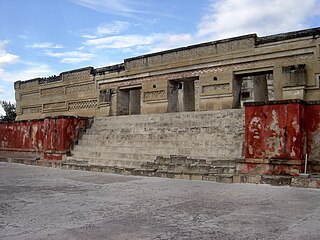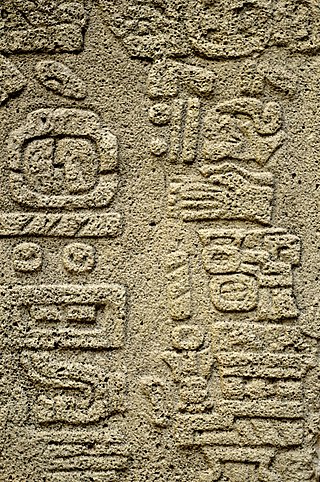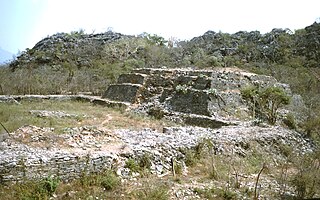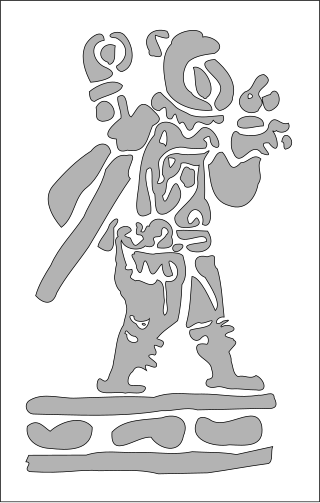Related Research Articles

Monte Albán is a large pre-Columbian archaeological site in the Santa Cruz Xoxocotlán Municipality in the southern Mexican state of Oaxaca. The site is located on a low mountainous range rising above the plain in the central section of the Valley of Oaxaca, where the latter's northern Etla, eastern Tlacolula, and southern Zimatlán and Ocotlán branches meet. The present-day state capital Oaxaca City is located approximately 9 km (6 mi) east of Monte Albán.

Mitla is the second-most important archeological site in the state of Oaxaca in Mexico, and the most important of the Zapotec culture. The site is located 44 km from the city of Oaxaca, in the upper end of the Tlacolula Valley, one of the three cold, high valleys that form the Central Valleys Region of the state. At an elevation of 4,855 ft, surrounded by the mountains of the Sierra Madre del Sur, the archeological site is within the modern municipality of San Pablo Villa de Mitla. It is 24 mi (38 km) southeast of Oaxaca city. While Monte Albán was the most important politically of the Zapotec centers, Mitla became the main religious one in a later period as the area became dominated by the Mixtec.
El Palmillo is a Mesoamerican Classic Period archaeological site located in the Valley of Oaxaca, associated with the pre-Columbian Zapotec civilization which was centered in the valley and the surrounding highlands of the present-day state of Oaxaca, Mexico. Located on a hilltop in the eastern Tlacolula arm of the valley, El Palmillo is just to the south of the pre-Columbian site of Mitla and to the east of the major Zapotec regional center, Monte Albán.

San José Mogote is a pre-Columbian archaeological site of the Zapotec, a Mesoamerican culture that flourished in the region of what is now the Mexican state of Oaxaca. A forerunner to the better-known Zapotec site of Monte Albán, San José Mogote was the largest and most important settlement in the Valley of Oaxaca during the Early and Middle Formative periods of Mesoamerican cultural development.

The Zapotec civilization was an indigenous pre-Columbian civilization that flourished in the Valley of Oaxaca in Mesoamerica. Archaeological evidence shows that their culture originated at least 2,500 years ago. The Zapotec archaeological site at the ancient city of Monte Albán has monumental buildings, ball courts, magnificent tombs and grave goods, including finely worked gold jewelry. Monte Albán was one of the first major cities in Mesoamerica. It was the center of a Zapotec state that dominated much of the territory which today is known as the Mexican state of Oaxaca.

The Central Valleys of Oaxaca, also simply known as the Oaxaca Valley, is a geographic region located within the modern-day state of Oaxaca in southern Mexico. In an administrative context, it has been defined as comprising the districts of Etla, Centro, Zaachila, Zimatlán, Ocotlán, Tlacolula and Ejutla. The valley, which is located within the Sierra Madre Mountains, is shaped like a distorted and almost upside-down “Y,” with each of its arms bearing specific names: the northwestern Etla arm, the central southern Valle Grande, and the Tlacolula arm to the east. The Oaxaca Valley was home to the Zapotec civilization, one of the earliest complex societies in Mesoamerica, and the later Mixtec culture. A number of important and well-known archaeological sites are found in the Oaxaca Valley, including Monte Albán, Mitla, San José Mogote and Yagul. Today, the capital of the state, the city of Oaxaca, is located in the central portion of the valley.

The Zapotec script is the writing system of the Zapotec culture and represents one of the earliest writing systems in Mesoamerica. Rising in the late Pre-Classic era after the decline of the Olmec civilization, the Zapotecs of present-day Oaxaca built an empire around Monte Albán. One characteristic of Monte Albán is the large number of carved stone monuments one encounters throughout the plaza. There and at other sites, archaeologists have found extended text in a glyphic script.
Joyce Marcus is a Latin American archaeologist and professor in the Department of Anthropology, College of Literature, Science, and the Arts at the University of Michigan, Ann Arbor. She also holds the position of Curator of Latin American Archaeology, University of Michigan Museum of Anthropological Archaeology. Marcus has published extensively in the field of Latin American archaeological research. Her focus has been primarily on the Zapotec, Maya, and coastal Andean civilizations of Central and South America. Much of her fieldwork has been concentrated in the Valley of Oaxaca, Mexico. She is known for her "Dynamic model", four-tiered hierarchy, and her use of interdisciplinary study.

Guiengola is a Zapotec archeological site located 14 km (8.7 mi) north of Tehuantepec, and 243 km (151 mi) southeast of Oaxaca city on Federal Highway 190. The visible ruins are located between a hill and a river, each carries the name of Guiengola. The name means "large stone" in the local variant of the Zapotec language. There are two main tombs that have been excavated, and both seem to be family interment sites. Both have front chambers that are for religious idols, while the rear chambers are for the burial of important people. The site also has fortified walls, houses, ballgame fields, other tombs and a very large "palace" with remains of artificial ponds and terraces. In the center of the site are 2 plazas, one lower than the other, and 2 pyramids, one to the east and one to the west.

Yagul is an archaeological site and former city-state associated with the Zapotec civilization of pre-Columbian Mesoamerica, located in the Mexican state of Oaxaca. The site was declared one of the country's four Natural Monuments on 13 October 1998. The site is also known locally as Pueblo Viejo and was occupied at the time of the Spanish Conquest. After the Conquest the population was relocated to the nearby modern town of Tlacolula where their descendants still live.

Lambityeco is a small archaeological site about three kilometers west of the city of Tlacolula de Matamoros in the Mexican state of Oaxaca. It is located just off Highway 190 about 25 km (16 mi) east from the city of Oaxaca en route to Mitla. The site has been securely dated to the Late Classical Period.

Dainzú is a Zapotec archaeological site located in the eastern side of the Valles Centrales de Oaxaca, about 20 km south-east of the city of Oaxaca, Oaxaca State, Mexico. It is an ancient village near to and contemporary with Monte Albán and Mitla, with an earlier development. Dainzú was first occupied 700-600 BC but the main phase of occupation dates from about 200 BC to 350 AD. The site was excavated in 1965 by Mexican archaeologist Ignacio Bernal.

Richard E. Blanton is an American anthropologist, archaeologist, and academic. He is most renowned for his archaeological field and theoretical research into the development of civilizations in pre-Columbian Mesoamerica, particularly those from the central Mexican plateau and Valley of Oaxaca regions. Blanton taught at Rice University and Hunter College of the City University of New York before joining the faculty at Purdue University in 1976. He is currently Professor Emeritus of Anthropology at Purdue's College of Liberal Arts.
Robert Norman Zeitlin is an American professor emeritus of anthropology at Brandeis University. He has a B.A. in psychology from Cornell University, a B.S. in aeronautical engineering from Boston University, an M.A. in anthropology from City University of New York, and a M.Phil. and Ph.D. in anthropology from Yale University.
Santa Inés Yatzeche is a town and municipality in Oaxaca in south-western Mexico.
Mixteca Alta Formative Project (2003–present) is an archaeological project directed by Andrew Balkansky that focuses on the Mixtec of Oaxaca, Mexico. The project, which is funded by the National Science Foundation, the National Geographic Society, and the H. John Heinz III Fund, seeks to understand Mixtec origins and their transition to urbanism. Excavations are currently taking place at the ancient site of Tayata.
Pusilhá is an archaeological site in Belize. The location of this Late Classic Maya urban complex, along the east and west flow of trade, made the city a major transfer point for economic activities in the whole region. In addition, the city gave archaeologists a historical view of a secondary Maya site. Large and extended excavation efforts have changed the overall picture of Maya social and political relationships between larger and smaller cities and challenged the prevailing view of conquest and absorption of smaller cities into the larger cities in the region. The research conducted at Pusilhá began in 1927 and continues to this day.
Tierras Largas is a formative-period archaeological site located in the Etla arm in the Valley of Oaxaca in Mexico. It is considered to be one of the first villages where sedentism originated in the Oaxaca area. The name is Spanish for “Long Lands”.

Peter N. Peregrine is an American anthropologist, registered professional archaeologist, and academic. He is well known for his promotion of the use of science in anthropology, and for his popular textbook Anthropology. Peregrine did dissertation research on the evolution of the Mississippian culture of North America, and conducted fieldwork on Bronze Age cities in Syria. He is currently Professor of Anthropology and Museum Studies at Lawrence University and Research Associate of the Human Relations Area Files at Yale University. From 2012 to 2018 he was an External Professor at the Santa Fe Institute.
Elsa Marion Redmond is an American archaeologist at the American Museum of Natural History. She specializes in Latin American archaeology. She is an elected member of the National Academy of Sciences and the American Academy of Arts and Sciences.
References
- ↑ Blanton, Richard; Feinman, Gary M.; Kowalewski, Stephen A.; Nicholas, Linda M. (2022). Ancient Oaxaca, 2nd Edition. New York: Cambridge University Press. ISBN 978-0521577878.
- ↑ "Gary Feinman". Academia.edu. Retrieved 2012-04-01.
- ↑ SSCI average of 18 citations per year (http://apps.webofknowledge.com/CitationReport.do?product=WOS&search_mode=CitationReport&SID=3B3aD5bGcA4jhp77faL&page=1&cr_pqid=11&viewType=summary)
- ↑ "Journal of Archaeological Research". Springer. Retrieved 2012-04-01.
- ↑ "SAA Bulletin 15(1)" . Retrieved 2012-04-01.
- ↑ Edward W. Lempinen, ed. (28 October 2005). "AAAS News & Notes". American Association for the Advancement of Science. Archived from the original on 18 March 2013. Retrieved 2012-04-01.
- ↑ Kowaleski, Stephen, ed. (1982). Monte Alban's Hinterland, Part II. Ann Arbor: University of Michigan Museum. ISBN 978-0915703180.
- ↑ Fish, Suzanne (2009). The Archaeology of Regions: The Case for Full Coverage Survey. New York: Percheron Press. ISBN 978-0979773105.
- ↑ Blanton, Richard; Feinman, Gary M. (1984). "The Mesoamerican World-System". American Anthropologist . 86 (3): 673–682. doi:10.1525/aa.1984.86.3.02a00100.
- ↑ Kohl, Philip L. (1987). "The Use and Abuse of World-Systems Theory". Advances in Archaeological Method and Theory (11): 1–35.
- ↑ Peregrine, Peter N.; Feinman, Gary, eds. (1996). Pre-Columbian World-Systems. Madison: Prehistory Press. ISBN 978-1881094166.
- ↑ Blanton, Richard, ed. (1996). "A Dual-Processual Theory for the Evolution of Mesoamerican Civilization". Current Anthropology . 37 (1): 1–14. doi:10.1086/204471. S2CID 51751402.
- ↑ Mills, Barbara J., ed. (2000). Alternative Leadership Strategies in the Prehispanic Southwest. Tucson: University of Arizona Press. ISBN 978-0816520282.